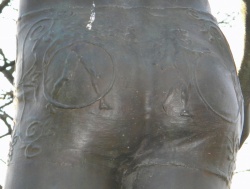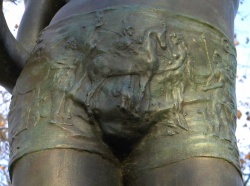The Mask Seller (Zacharie Astruc): Difference between revisions
No edit summary |
No edit summary |
||
| (16 intermediate revisions by the same user not shown) | |||
| Line 1: | Line 1: | ||
[[Image:ASTRUC Zacharie 1883 Le marchand de masques 1536x2048.jpg|350px|right]] | |||
''' | '''The Mask Seller''' is a bronze statue by the painter, poet, critic and French sculptor Zacharie Astruc, in 1883. | ||
The work is exhibited in the Luxembourg Gardens, Paris. | |||
This sculpture depicts a young boy standing, wearing only a pair of figure-hugging shorts embroidered with mythological designs and a pair of sandals. Supported on the right leg, he holds in his left hand lifted above him a mask of Victor Hugo. At his feet around the base are other masks representing famous characters from the end of the 19th century (writers, painters, musicians, a sculptor, and a single politician). | |||
==Boylove References== | |||
[[Image:ASTRUC Zacharie 1883 Le marchand de masques (détail) 500x378.jpg|250px|left]] | |||
It is probably no coincidence that the pattern decorating the left buttock of the boy is a reproduction of a drawing of the famous krater type Greek red-figure pottery of the 'Berlin painter' <ref>http://en.wikipedia.org/wiki/Berlin_Painter</ref>, representing [[Ganymede]] naked with a [[Trochus/Hoop|hoop and a rooster]]. While leaving out the other side of the vase, where the tip of Zeus’s spear completes the sexual symbolism, this discreet evocation is clearly pedosexual.. | |||
[[Image:ASTRUC Zacharie 1883 Le marchand de masques (détail) 500x372.jpg|250px|left]] | |||
The front of the shorts are just as amazing, a horse covers the boy's quite prominent defining characteristic. What is the suggestion here? That there is a possibility that the horse will rear up? Or is it an allusion to the myth of Ganymede, which Zeus compensated his removal by offering his father wonderful horses? One should note however, that the animal is being petted by the hand of a woman. | |||
Taken in its entirety, it could be interpreted as an affirmation and an illustration of the sexual character, both desirable and desiring, of adolescence, while at the same time, its bisexual nature. | |||
{{Clr}}<br> | {{Clr}}<br> | ||
---- | ---- | ||
{{Clr}} | {{Clr}} | ||
<br> | <br> | ||
[[Image:ASTRUC Zacharie 1883 Le marchand de masques (détail) 1620x1080.jpg|380px| | [[Image:ASTRUC Zacharie 1883 Le marchand de masques (détail) 1620x1080.jpg|380px|left]][[Image:ASTRUC Zacharie 1883 Le marchand de masques (détail) 814x1080.jpg|200px]] | ||
{{Clr}} | {{Clr}} | ||
== Notes et références == | == Notes et références == | ||
{{reflist}} | |||
* ↑ Jardins du Luxembourg : 48° 50′ 46.32″ N, 2° 20′ 18.44″ E. | |||
* [https://fr.boywiki.org/wiki/Le_marchand_de_masques_(Zacharie_Astruc) The Mask Seller (Zacharie Astruc) '''→''' fr:Le marchand de masques (Zacharie Astruc}] | |||
Latest revision as of 14:04, 27 September 2013

The Mask Seller is a bronze statue by the painter, poet, critic and French sculptor Zacharie Astruc, in 1883.
The work is exhibited in the Luxembourg Gardens, Paris.
This sculpture depicts a young boy standing, wearing only a pair of figure-hugging shorts embroidered with mythological designs and a pair of sandals. Supported on the right leg, he holds in his left hand lifted above him a mask of Victor Hugo. At his feet around the base are other masks representing famous characters from the end of the 19th century (writers, painters, musicians, a sculptor, and a single politician).
Boylove References

It is probably no coincidence that the pattern decorating the left buttock of the boy is a reproduction of a drawing of the famous krater type Greek red-figure pottery of the 'Berlin painter' [1], representing Ganymede naked with a hoop and a rooster. While leaving out the other side of the vase, where the tip of Zeus’s spear completes the sexual symbolism, this discreet evocation is clearly pedosexual..

The front of the shorts are just as amazing, a horse covers the boy's quite prominent defining characteristic. What is the suggestion here? That there is a possibility that the horse will rear up? Or is it an allusion to the myth of Ganymede, which Zeus compensated his removal by offering his father wonderful horses? One should note however, that the animal is being petted by the hand of a woman.
Taken in its entirety, it could be interpreted as an affirmation and an illustration of the sexual character, both desirable and desiring, of adolescence, while at the same time, its bisexual nature.

Notes et références
- ↑ Jardins du Luxembourg : 48° 50′ 46.32″ N, 2° 20′ 18.44″ E.
